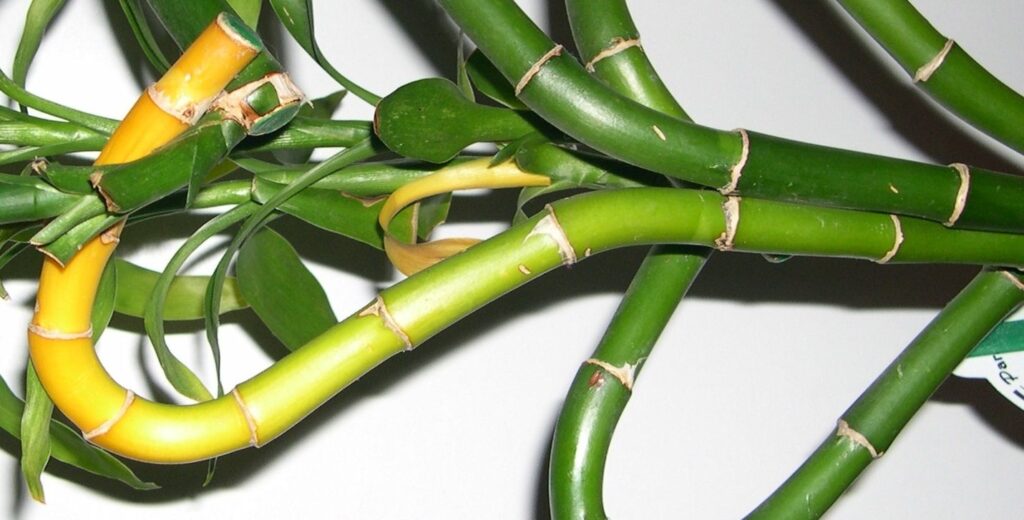Feng Shui believes that lucky bamboo, a common houseplant in residences, workplaces, and retail establishments, may aid to attract luck and success. If the normally green leaves on your bamboo suddenly begin to turn yellow, it could seem a little unfortunate.

Reasons for Lucky Bamboo Plant Yellowing
The stems and leaves of a healthy fortunate bamboo plant should be a dark to brilliant green color. There are a number of reasons why a plant’s stem or leaves can be becoming yellow, including:
Too much daylight
Too much daylight If lucky bamboo is placed in a window with excessive direct sunshine, which can burn the leaves and stress the plant, it frequently turns yellow.
Too much fertilizer
Too much fertilizer One or two mild applications of fertilizer each year are plenty for a happy bamboo plant.
Lack of Water
Lucky bamboo can dry out rather fast after being planted in soil; this might stress the plant and cause the leaves to become yellow, wilt, and eventually die.
Water of poor quality
If you’ve been using tap water on your lucky bamboo plant, try using bottled, filtered, or distilled water instead.
Wrong Temperature
Wrong Temperature It typically thrives in growth settings between 65 and 90 degrees Fahrenheit as a houseplant. Plants can become stressed by heating or cooling vents, so be sure to put them far from these sources.
Insect infestation
Insect infestation Small insects called aphids and spider mites are frequent offenders. These pests are typically visible with a magnifying lens under close observation.
Tips for Caring for Yellow Lucky Bamboo
A fortunate bamboo plant may become yellow for a number of reasons, so treating the plant necessitates some trial and error. To lessen yellowing leaves, take into account the following fortunate bamboo maintenance advice:
- Trim the plant. Yellow leaves may be taken from the plant by carefully plucking them from the stem.
- Relocate the plant. Move your plant to a location with indirect light or with it facing the sun. Your lucky bamboo is in a good place if you observe that it is growing toward the sun—this is a normal characteristic. Even the light is used by cultivators to form these plants.
Utilize a freshwater source. Water replacement is an excellent early step. If your plant is in water, discard the old water and replace it with new water. Root rot can be brought on by bacteria in stagnant water.
- Use fertilizer sparingly. Your lucky bamboo may turn yellow if it receives too much fertilizer. If you fertilize your plant, consider cutting back on the quantity and frequency of applications.
- Check for pests on your plant. Use a magnifying lens to closely examine your plants to check for pests. If you come across them, try removing them using a combination of water and rubbing alcohol or water and a vegetable soap.
- Cut the golden stem short. Trim away as much of the yellow areas as you can before the entire plant turns yellow, and then place what is left in new, clean water.
Caring For Your Lucky Bamboo Plants
Because it isn’t bamboo, Lucky Bamboo, also known as Dracaena Sanderiana, has a name that may be misleading. Instead of using bamboo as a primary material, focus on Dracaena care.
People maintain several dracaena species in their homes and workplaces for a variety of reasons.
They could raise the air quality near them. According to Chinese tradition, this plant is appropriate for the Feng Shui environment.
Some people think that Lucky Bamboo portends luck and happiness. Therefore, if such symbolism is not blossoming nicely, it is normal to feel depressed.
The Lucky Bamboo stems require little upkeep. It can grow in both soil and water, although the soil is where it grows best.
It thrives in diffused light and prefers temperatures between 65 and 95 degrees Fahrenheit.
Soil Quality
Keep the plant in the soil, and it will live longer. Although it only survives in water for about one or two years, it is advisable to cultivate it on soil for longer life.
For the Lucky Bamboo plant, keep the soil just barely moist. Underwatering or overwatering will both make the plant wither.
For optimum support, use very little fertilizer or pesticide.
Water Quality
Always keep the roots submerged while growing a plant in water, and change the water every week.
Use filtered water in place of tap water if your water has high levels of fluoride and chlorine (hard water). Water with high amounts of fluoride and chlorine is hazardous to plants.
Temperature
The optimum temperature range for the Lucky Bamboo plant is between 65° and 95° Fahrenheit. Winterize the plant by keeping it away from windows and drafts.
Lighting
Indirect sunlight works nicely for Sunlight Lucky Bamboo. The leaves may burn in direct sunlight.
Move the plant to some shade if the leaves start to turn brown. If you like, set a time limit and just let the plant be exposed to morning or evening sunlight.
Toxicity
Animals are poisoned by the Lucky Bamboo plant’s leaves and other components.